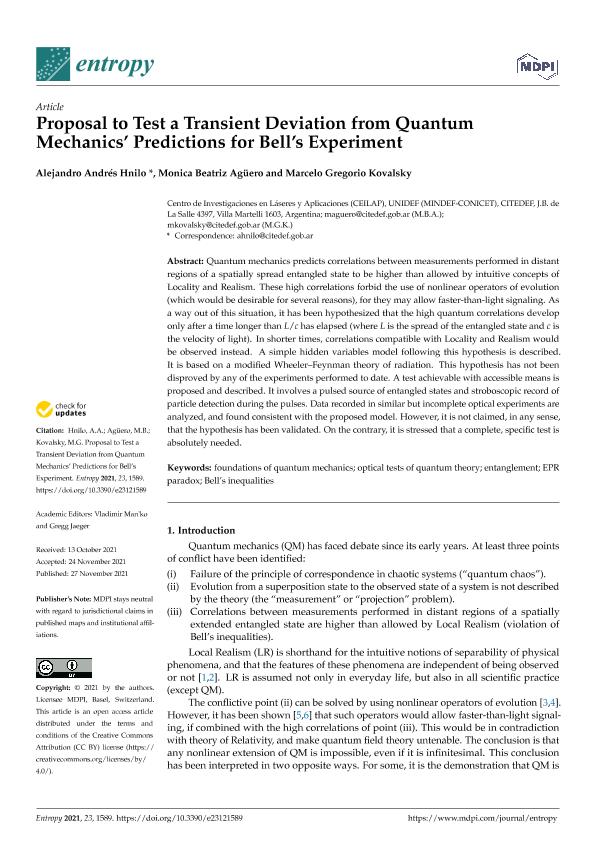Mostrar el registro sencillo del ítem
dc.contributor.author
Hnilo, Alejandro Andrés

dc.contributor.author
Agüero, Mónica Beatriz

dc.contributor.author
Kovalsky, Marcelo Gregorio

dc.date.available
2023-11-06T12:18:16Z
dc.date.issued
2021-12
dc.identifier.citation
Hnilo, Alejandro Andrés; Agüero, Mónica Beatriz; Kovalsky, Marcelo Gregorio; Proposal to test a transient deviation from quantum mechanics’ predictions for bell’s experiment; Molecular Diversity Preservation International; Entropy; 23; 12; 12-2021; 1-13
dc.identifier.issn
1099-4300
dc.identifier.uri
http://hdl.handle.net/11336/217064
dc.description.abstract
Quantum mechanics predicts correlations between measurements performed in distant regions of a spatially spread entangled state to be higher than allowed by intuitive concepts of Locality and Realism. These high correlations forbid the use of nonlinear operators of evolution (which would be desirable for several reasons), for they may allow faster-than-light signaling. As a way out of this situation, it has been hypothesized that the high quantum correlations develop only after a time longer than L/c has elapsed (where L is the spread of the entangled state and c is the velocity of light). In shorter times, correlations compatible with Locality and Realism would be observed instead. A simple hidden variables model following this hypothesis is described. It is based on a modified Wheeler–Feynman theory of radiation. This hypothesis has not been disproved by any of the experiments performed to date. A test achievable with accessible means is proposed and described. It involves a pulsed source of entangled states and stroboscopic record of particle detection during the pulses. Data recorded in similar but incomplete optical experiments are analyzed, and found consistent with the proposed model. However, it is not claimed, in any sense, that the hypothesis has been validated. On the contrary, it is stressed that a complete, specific test is absolutely needed.
dc.format
application/pdf
dc.language.iso
eng
dc.publisher
Molecular Diversity Preservation International

dc.rights
info:eu-repo/semantics/openAccess
dc.rights.uri
https://creativecommons.org/licenses/by/2.5/ar/
dc.subject
BELL’S INEQUALITIES
dc.subject
ENTANGLEMENT
dc.subject
EPR PARADOX
dc.subject
FOUNDATIONS OF QUANTUM MECHANICS
dc.subject
OPTICAL TESTS OF QUANTUM THEORY
dc.subject.classification
Óptica

dc.subject.classification
Ciencias Físicas

dc.subject.classification
CIENCIAS NATURALES Y EXACTAS

dc.title
Proposal to test a transient deviation from quantum mechanics’ predictions for bell’s experiment
dc.type
info:eu-repo/semantics/article
dc.type
info:ar-repo/semantics/artículo
dc.type
info:eu-repo/semantics/publishedVersion
dc.date.updated
2023-11-06T09:53:40Z
dc.journal.volume
23
dc.journal.number
12
dc.journal.pagination
1-13
dc.journal.pais
Suiza

dc.description.fil
Fil: Hnilo, Alejandro Andrés. Consejo Nacional de Investigaciones Científicas y Técnicas. Unidad de Investigación y Desarrollo Estratégico para la Defensa. Ministerio de Defensa. Unidad de Investigación y Desarrollo Estratégico para la Defensa; Argentina
dc.description.fil
Fil: Agüero, Mónica Beatriz. Consejo Nacional de Investigaciones Científicas y Técnicas. Unidad de Investigación y Desarrollo Estratégico para la Defensa. Ministerio de Defensa. Unidad de Investigación y Desarrollo Estratégico para la Defensa; Argentina
dc.description.fil
Fil: Kovalsky, Marcelo Gregorio. Consejo Nacional de Investigaciones Científicas y Técnicas. Unidad de Investigación y Desarrollo Estratégico para la Defensa. Ministerio de Defensa. Unidad de Investigación y Desarrollo Estratégico para la Defensa; Argentina
dc.journal.title
Entropy

dc.relation.alternativeid
info:eu-repo/semantics/altIdentifier/doi/http://dx.doi.org/10.3390/e23121589
Archivos asociados
